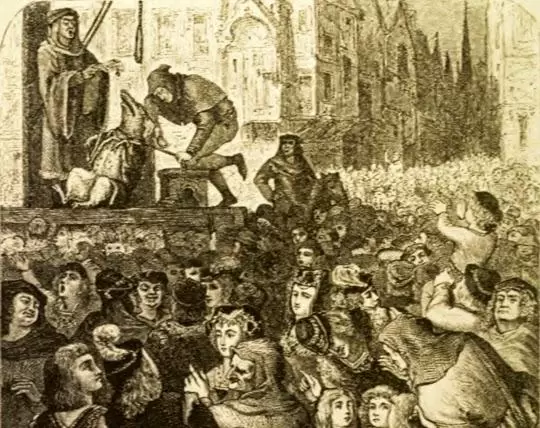Animals in Court: Animal Trials and Executions in History

In 1386, a large crowd had gathered in the old Norman city of Falaise to witness the execution of a convicted murderer. The people eagerly awaited the execution. After a short wait, the criminal was brought forth for execution.
The criminal to be executed was a pig who had a “bad habit of eating babies in the street” and had his head and foreleg mutilated before he was hanged.
Court trials of non-human animals have been practiced throughout history in many parts of the world, especially in medieval Europe. Although the animals tried or subsequently executed in these trials were mostly pigs, many animal species, including roosters and mice, frogs and snakes, and even insects such as grasshoppers and termites, were considered subjects of the law and were tried and found guilty.

The most detailed book on the subject, written by Edmund P. Evans, is “Penal Prosecution and Death Penalties of Animals”, which details 196 cases from 14 countries. However, the legal historian Hampton L. Carson also has a work called “Animal and Insect Trials in Falaise” on this subject. Describing the last moments of the sow in this work, Carson said the following about the trial and execution of animals:
“This wide distribution in time and region shows how widespread the practice of judging and executing animals was. Taking a look at history, we can say that the most cases of this practice are seen in France, but this is because French historians, more than any other nation, carefully record its practices in their works.”
First, let’s record some historical examples of animal trials and punishments:
A bull attacking people in a village in France in 1314 was hanged after being caught.
In 1474, a chicken whose egg laying was found to be abnormal was burned to death in Basel.
In 1494, a 4-year-old pig named Cecile was accused of causing the death of a baby. Taken to an animal court, Cecile was executed after being tried.
The dog, which attacked the members of the court and injured one of them in France in 1712, was imprisoned in a dungeon by being chained for a year.
We said that such trials and executions are common in France. Let’s cite a few examples in more detail:
In December 1457, the French city of Savigny witnessed a bloody murder. A pig, along with her six cubs, resorted to violence and killed five-year-old Jehan Martin. Seeing this, the authorities imprisoned all seven pigs after they were caught red-handed. These pigs were later taken to court. Esther Cohen, author of Law, Folklore and Animal Science, wrote that from the very beginning of the legal proceedings, the owner of the pig was also tried as an official defendant. But this person was charged with only negligence and faced no real punishment for the murder of five-year-old Jehan Martin. The sanction given to the pig was death. After hearing the testimony and consulting with people knowledgeable in local law, the judge sentenced the criminal, the boar, to be hanged by its hind legs, in accordance with Burgundian tradition. The six piglets escaped death as no one could prove their involvement in the crime, even though they were covered in blood.

When all was settled, the court summoned a professional executioner to carry out the sentence and had the criminal in question executed.
In all instances of recorded animal trials, the judge, lawyers, legislators, and executioners took the case as seriously as any other murder. In his book Animal Trials, historian Peter Dinzelbacher says that these trials were considered quite serious, especially since experienced judges were appointed for animal trials.
These pig trials in Falaise and Savigny are typical animal trials. In addition, pigs were “responsible for the deaths of many infants” and were common criminals, although records also show bloodthirsty cows, horses, and dogs as the occasional subject of court cases. “The Savigny case is important because of its diligence in following legal customs and proper judicial procedure,” says Cohen.
We talked about the importance attached to such animal hearings. Records even write that these animals were often represented by some of the best lawyers of the time.

Carson wrote that Bartholomew Chassenée, an important figure in French jurisprudence and legal philosophy, even attempted to defend rats in court. The client of this distinguished lawyer of the time, you heard right, are rats. It is written in the records that this event took place in the town of Autun in 1522. The townspeople accused the rats of ruining the barley crop. Subsequently, the rats were summoned to the court, but, of course, they could not attend the hearing.
The mice’s lawyer, Chassenée, argued before the court that, according to the current law, the accused could ignore a subpoena. Thus, the lawyer was able to provide a suitable legal justification for the mice not attending the hearing. He also claimed that the town was full of cats, so the rats had to ignore the summons. Ultimately, the case was unsuccessful and Chassenée pursued a brilliant career with human clients.
Even if the lawyers who are given to defend animals in the courts are not so skilled, animal defendants are given all the legal rights and legal process that are given to humans. For example:
Historian Jen Girgen wrote that in 1713, a Franciscan monastery in Brazil was battling insects that spoiled food, devoured furniture, and gnawed at every part of the monastery. Unable to cope with this situation, the priests filed a complaint with the bishop, and the insects were subsequently sued. During the trial, the insects’ lawyer argued that these creatures were God’s creatures and therefore had the right to food. The final decision was a compromise; Priests are ordered to provide a habitat for insects. However, there is no information on how well this solution works.
Apart from these events we have mentioned, there are many other examples of animals being brought before the court and subjected to various penal sanctions. However, since the 20th century, with the rise of animal rights to the fore, such interesting traditions have begun to be abandoned.



